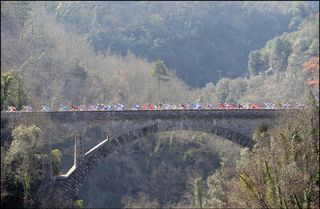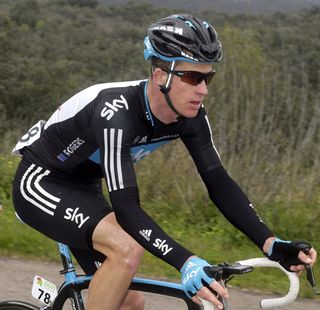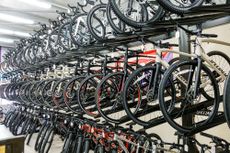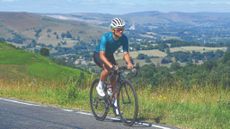Paris-Nice 2011: Not so nice
By adding a long time trial to the route of Paris-Nice, have the race organisers ASO spoiled the character of the race?
Words by Lionel Birnie

For the first time since 1996, Paris-Nice will get underway with a conventional road stage rather than an individual time trial.
But it is the inclusion of a 27-kilometre time trial between Rognes and Aix-les-Bains on Friday that significantly alters the character of the race.
Not that it is necessarily a bad thing, far from it, just that the Race to the Sun has always favoured a certain type of rider and a certain kind of race.
This year, the pendulum swings away from the puncheurs and towards those who can ride against the clock. Or rather, the odds are heavily against those who are not so good against the clock – such as Frank Schleck.
It was interesting to see that Katusha decided to pull Joaquim Rodriguez out of Paris-Nice and send him to Tirreno-Adriatico instead. The Spaniard was sixth overall in Nice last year but is not good enough at time trialling to be a realistic podium hope.
Get The Leadout Newsletter
The latest race content, interviews, features, reviews and expert buying guides, direct to your inbox!
Instead, the route favours the likes of Michael Rogers or Levi Leipheimer and – for this year at least – loses a little bit of the anarchic spirit that has made it such a popular and entertaining early season battleground.
The last time a time trial this long was included on the Paris-Nice menu was in 1968. In the seventies and eighties, the Col d’Eze hill-climb was often the decisive stage but that was dropped in 1996. That year, Chris Boardman won a predominantly flat 20-kilometre time trial from Antibes to Nice to secure third place overall, behind the winner Laurent Jalabert and runner-up Lance Armstrong.
In 2000 and 2001, Laurent Fignon – who had taken over the race from the Leuillot family – reinstated the Col d’Eze time trial but when ASO rescued the race from financial oblivion they agreed to finish on the Promenade des Anglais, the big boulevard on the seafront in the centre of Nice.
Since 1997, the race has kicked off with a time trial – sometimes as short (four kilometres in 2005), sometimes longer (13km in 2004). After a couple of flat stages, usually held in the freezing cold, the race hits the hills. Although there have been experiments with summit finishes in recent years, the traditional landscape of Paris-Nice is twisty, lumpy rural roads rather than out-and-out cols.
It’s a generalisation, but you can often tell how rural the territory is by the number of hyphens in the town names. Grippy surfaces, challenging climbs, although rarely going above about 800 metres above sea level because of the early spring weather, are what the race is all about.
There is plenty of that this year. Stage three from Cosne-Cours-sur-Loire to Nuits-Saint-Georges is rolling. The following day’s stage from Creches-sur-Saone to Belleville is relentlessly hilly, with seven second and third-category climbs. Stage five from Saint-Symphorien-sur-Coise to Vernoux-en-Vivarais also has seven categorised climbs, with the first category Col de la Mûre, the most notable, coming at the end.
And then there’s the time trial, which in this context is the equivalent of a clumsy last paragraph in an elegantly-written story.

It will be interesting to see the effect the time trial has on the tactics. The likelihood is that the teams with a strong time triallist will fight to keep things tight until Friday and then treat the weekend’s stages as almost a two-day stage race of their own.
Those final couple of days do offer a slim chance for those who have lost time in their skinsuits and pointy helmets to get it back. Stage seven from Brignoles to Biot is hilly in the middle, with two first-category climbs. The final stage starts and finishes in Nice and takes in the traditional loop that covers La Turbie and the Col d’Eze. As we’ve seen in the past, short stages like this, when raced aggressively, can cause an upset but a switched-on team with a lead to defend shouldn’t really have too much trouble. The descent from the Col d’Eze is shallow and wide, favouring chasers.
The bottom line, though, is that Paris-Nice can do without slipping into the all-too-familiar format favoured by other week-long stage races. The beauty of the event is that it encourages road racing. There’s a certain joie de vivre about the journey to the sunshine. The cold at the start of the week gets everyone racing, the rising warmth brings the riders out of their shells as if awakening from a winter’s hibernation.
A time trial? Well, it just doesn’t quite fit into the narrative, somehow.

Thank you for reading 20 articles this month* Join now for unlimited access
Enjoy your first month for just £1 / $1 / €1
*Read 5 free articles per month without a subscription

Join now for unlimited access
Try first month for just £1 / $1 / €1
Edward Pickering is a writer and journalist, editor of Pro Cycling and previous deputy editor of Cycle Sport. As well as contributing to Cycling Weekly, he has also written for the likes of the New York Times. His book, The Race Against Time, saw him shortlisted for Best New Writer at the British Sports Book Awards. A self-confessed 'fair weather cyclist', Pickering also enjoys running.
-
 Undercover Mechanic: Contrary to popular belief, the bike industry is not collapsing - but disinformation is rife
Undercover Mechanic: Contrary to popular belief, the bike industry is not collapsing - but disinformation is rifeThe overstocking amid the Covid spike is problematic, but some businesses are thriving, argues our insider
By Undercover Mechanic Published
-
 You need to ride easy to get faster - and that might be easier than 'Zone 2', here's why
You need to ride easy to get faster - and that might be easier than 'Zone 2', here's whyIt's ell known that easy riding is the bedrock of endurance, but what exactly do we mean by ‘easy’? Charlie Allenby seeks clarification
By Charlie Allenby Published